Various Works Read online
Page 59
into the male). For if a hen-bird is in process of producing
wind-eggs and is then trodden by the cock before the egg has begun
to whiten and while it is all still yellow, then they become fertile
instead of being wind-eggs. And if while it is still yellow she be
trodden by another cock, the whole brood of chicks turn out like the
second cock. Hence some of those who are anxious to rear fine birds
act thus; they change the cocks for the first and second treading, not
as if they thought that the semen is mingled with the egg or exists in
it, or that it comes from all parts of the cock; for if it did it
would have come from both cocks, so that the chick would have all
its parts doubled. But it is by its force that the semen of the male
gives a certain quality to the material and the nutriment in the
female, for the second semen added to the first can produce this
effect by heat and concoction, as the egg acquires nutriment so long
as it is growing.
The same conclusion is to be drawn from the generation of
oviparous fishes. When the female has laid her eggs, the male spinkles
the milt over them, and those eggs are fertilized which it reaches,
but not the others; this shows that the male does not contribute
anything to the quantity but only to the quality of the embryo.
From what has been said it is plain that the semen does not come
from the whole of the body of the male in those animals which emit it,
and that the contribution of the female to the generative product is
not the same as that of the male, but the male contributes the
principle of movement and the female the material. This is why the
female does not produce offspring by herself, for she needs a
principle, i.e. something to begin the movement in the embryo and to
define the form it is to assume. Yet in some animals, as birds, the
nature of the female unassisted can generate to a certain extent,
for they do form something, only it is incomplete; I mean the
so-called wind-eggs.
22
For the same reason the development of the embryo takes place in the
female; neither the male himself nor the female emits semen into the
male, but the female receives within herself the share contributed
by both, because in the female is the material from which is made
the resulting product. Not only must the mass of material exist
there from which the embryo is formed in the first instance, but
further material must constantly be added that it may increase in
size. Therefore the birth must take place in the female. For the
carpenter must keep in close connexion with his timber and the
potter with his clay, and generally all workmanship and the ultimate
movement imparted to matter must be connected with the material
concerned, as, for instance, architecture is in the buildings it
makes.
From these considerations we may also gather how it is that the male
contributes to generation. The male does not emit semen at all in some
animals, and where he does this is no part of the resulting embryo;
just so no material part comes from the carpenter to the material,
i.e. the wood in which he works, nor does any part of the
carpenter's art exist within what he makes, but the shape and the form
are imparted from him to the material by means of the motion he sets
up. It is his hands that move his tools, his tools that move the
material; it is his knowledge of his art, and his soul, in which is
the form, that moves his hands or any other part of him with a
motion of some definite kind, a motion varying with the varying nature
of the object made. In like manner, in the male of those animals which
emit semen Nature uses the semen as a tool and as possessing motion in
actuality, just as tools are used in the products of any art, for in
them lies in a certain sense the motion of the art. Such, then, is the
way in which these males contribute to generation. But when the male
does not emit semen, but the female inserts some part of herself
into the male, this is parallel to a case in which a man should
carry the material to the workman. For by reason of weakness in such
males Nature is not able to do anything by any secondary means, but
the movements imparted to the material are scarcely strong enough when
Nature herself watches over them. Thus here she resembles a modeller
in clay rather than a carpenter, for she does not touch the work she
is forming by means of tools, but, as it were, with her own hands.
23
In all animals which can move about, the sexes are separated, one
individual being male and one female, though both are the same in
species, as with man and horse. But in plants these powers are
mingled, female not being separated from male. Wherefore they generate
out of themselves, and do not emit semen but produce an embryo, what
is called the seed. Empedocles puts this well in the line: 'and thus
the tall trees oviposit; first olives...' For as the egg is an embryo,
a certain part of it giving rise to the animal and the rest being
nutriment, so also from a part of the seed springs the growing
plant, and the rest is nutriment for the shoot and the first root.
In a certain sense the same thing happens also in those animals
which have the sexes separate. For when there is need for them to
generate the sexes are no longer separated any more than in plants,
their nature desiring that they shall become one; and this is plain to
view when they copulate and are united, that one animal is made out of
both.
It is the nature of those creatures which do not emit semen to
remain united a long time until the male element has formed the
embryo, as with those insects which copulate. The others so remain
only until the male has discharged from the parts of himself
introduced something which will form the embryo in a longer time, as
among the sanguinea. For the former remain paired some part of a
day, while the semen forms the embryo in several days. And after
emitting this they cease their union.
And animals seem literally to be like divided plants, as though
one should separate and divide them, when they bear seed, into the
male and female existing in them.
In all this Nature acts like an intelligent workman. For to the
essence of plants belongs no other function or business than the
production of seed; since, then, this is brought about by the union of
male and female, Nature has mixed these and set them together in
plants, so that the sexes are not divided in them. Plants, however,
have been investigated elsewhere. But the function of the animal is
not only to generate (which is common to all living things), but
they all of them participate also in a kind of knowledge, some more
and some less, and some very little indeed. For they have
sense-perception, and this is a kind of knowledge. (If we consider
the value of this we find that it is of great importance compared with
the class of lifeless objects, but of little compared with the use
of the intellect. For against
the latter the mere participation in
touch and taste seems to be practically nothing, but beside absolute
insensibility it seems most excellent; for it would seem a treasure to
gain even this kind of knowledge rather than to lie in a state of
death and non-existence.) Now it is by sense-perception that an
animal differs from those organisms which have only life. But since,
if it is a living animal, it must also live; therefore, when it is
necessary for it to accomplish the function of that which has life, it
unites and copulates, becoming like a plant, as we said before.
Testaceous animals, being intermediate between animals and plants,
perform the function of neither class as belonging to both. As
plants they have no sexes, and one does not generate in another; as
animals they do not bear fruit from themselves like plants; but they
are formed and generated from a liquid and earthy concretion. However,
we must speak later of the generation of these animals.
Book II
1
THAT the male and the female are the principles of generation has
been previously stated, as also what is their power and their essence.
But why is it that one thing becomes and is male, another female? It
is the business of our discussion as it proceeds to try and point
out (1) that the sexes arise from Necessity and the first efficient
cause, (2) from what sort of material they are formed. That (3) they
exist because it is better and on account of the final cause, takes us
back to a principle still further remote.
Now (1) some existing things are eternal and divine whilst others
admit of both existence and non-existence. But (2) that which is noble
and divine is always, in virtue of its own nature, the cause of the
better in such things as admit of being better or worse, and what is
not eternal does admit of existence and non-existence, and can partake
in the better and the worse. And (3) soul is better than body, and
living, having soul, is thereby better than the lifeless which has
none, and being is better than not being, living than not living.
These, then, are the reasons of the generation of animals. For since
it is impossible that such a class of things as animals should be of
an eternal nature, therefore that which comes into being is eternal in
the only way possible. Now it is impossible for it to be eternal as an
individual (though of course the real essence of things is in the
individual)- were it such it would be eternal- but it is possible
for it as a species. This is why there is always a class of men and
animals and plants. But since the male and female essences are the
first principles of these, they will exist in the existing individuals
for the sake of generation. Again, as the first efficient or moving
cause, to which belong the definition and the form, is better and more
divine in its nature than the material on which it works, it is better
that the superior principle should be separated from the inferior.
Therefore, wherever it is possible and so far as it is possible, the
male is separated from the female. For the first principle of the
movement, or efficient cause, whereby that which comes into being is
male, is better and more divine than the material whereby it is
female. The male, however, comes together and mingles with the
female for the work of generation, because this is common to both.
A thing lives, then, in virtue of participating in the male and
female principles, wherefore even plants have some kind of life; but
the class of animals exists in virtue of sense-perception. The sexes
are divided in nearly all of these that can move about, for the
reasons already stated, and some of them, as said before, emit semen
in copulation, others not. The reason of this is that the higher
animals are more independent in their nature, so that they have
greater size, and this cannot exist without vital heat; for the
greater body requires more force to move it, and heat is a motive
force. Therefore, taking a general view, we may say that sanguinea are
of greater size than bloodless animals, and those which move about
than those which remain fixed. And these are just the animals which
emit semen on account of their heat and size.
So much for the cause of the existence of the two sexes. Some
animals bring to perfection and produce into the world a creature like
themselves, as all those which bring their young into the world alive;
others produce something undeveloped which has not yet acquired its
own form; in this latter division the sanguinea lay eggs, the
bloodless animals either lay an egg or give birth to a scolex. The
difference between egg and scolex is this: an egg is that from a
part of which the young comes into being, the rest being nutriment for
it; but the whole of a scolex is developed into the whole of the young
animal. Of the vivipara, which bring into the world an animal like
themselves, some are internally viviparous (as men, horses, cattle,
and of marine animals dolphins and the other cetacea); others first
lay eggs within themselves, and only after this are externally
viviparous (as the cartilaginous fishes). Among the ovipara some
produce the egg in a perfect condition (as birds and all oviparous
quadrupeds and footless animals, e.g. lizards and tortoises and most
snakes; for the eggs of all these do not increase when once laid).
The eggs of others are imperfect; such are those of fishes,
crustaceans, and cephalopods, for their eggs increase after being
produced.
All the vivipara are sanguineous, and the sanguinea are either
viviparous or oviparous, except those which are altogether
infertile. Among bloodless animals the insects produce a scolex, alike
those that are generated by copulation and those that copulate
themselves though not so generated. For there are some insects of this
sort, which though they come into being by spontaneous generation
are yet male and female; from their union something is produced,
only it is imperfect; the reason of this has been previously stated.
These classes admit of much cross-division. Not all bipeds are
viviparous (for birds are oviparous), nor are they all oviparous
(for man is viviparous), nor are all quadrupeds oviparous (for
horses, cattle, and countless others are viviparous), nor are they
all viviparous (for lizards, crocodiles, and many others lay eggs).
Nor does the presence or absence of feet make the difference
between them, for not only are some footless animals viviparous, as
vipers and the cartilaginous fishes, while others are oviparous, as
the other fishes and serpents, but also among those which have feet
many are oviparous and many viviparous, as the quadrupeds above
mentioned. And some which have feet, as man, and some which have
not, as the whale and dolphin, are internally viviparous. By this
character then it is not possible to divide them, nor is any of the
locomotive organs the cause of this difference, but it is those
animals which are more perfect in their nature and parti
cipate in a
purer element which are viviparous, for nothing is internally
viviparous unless it receive and breathe out air. But the more perfect
are those which are hotter in their nature and have more moisture
and are not earthy in their composition. And the measure of natural
heat is the lung when it has blood in it, for generally those
animals which have a lung are hotter than those which have not, and in
the former class again those whose lung is not spongy nor solid nor
containing only a little blood, but soft and full of blood. And as the
animal is perfect but the egg and the scolex are imperfect, so the
perfect is naturally produced from the more perfect. If animals are
hotter as shown by their possessing a lung but drier in their
nature, or are colder but have more moisture, then they either lay a
perfect egg or are viviparous after laying an egg within themselves.
For birds and scaly reptiles because of their heat produce a perfect
egg, but because of their dryness it is only an egg; the cartilaginous
fishes have less heat than these but more moisture, so that they are
intermediate, for they are both oviparous and viviparous within
themselves, the former because they are cold, the latter because of
their moisture; for moisture is vivifying, whereas dryness is furthest
removed from what has life. Since they have neither feathers nor
scales such as either reptiles or other fishes have, all which are
signs rather of a dry and earthy nature, the egg they produce is soft;
for the earthy matter does not come to the surface in their eggs any
more than in themselves. This is why they lay eggs in themselves,
for if the egg were laid externally it would be destroyed, having no
protection.
Animals that are cold and rather dry than moist also lay eggs, but
the egg is imperfect; at the same time, because they are of an
earthy nature and the egg they produce is imperfect, therefore it
has a hard integument that it may be preserved by the protection of
the shell-like covering. Hence fishes, because they are scaly, and

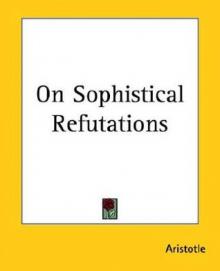 On Sophistical Refutations
On Sophistical Refutations The Categories
The Categories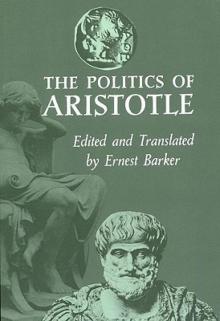 The Politics of Aristotle
The Politics of Aristotle Nicomachean Ethics
Nicomachean Ethics The Rhetoric & the Poetics of Aristotle
The Rhetoric & the Poetics of Aristotle POSTERIOR ANALYTICS
POSTERIOR ANALYTICS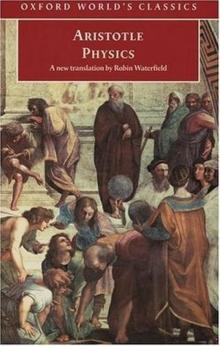 Physics
Physics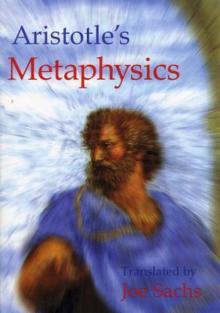 Metaphysics
Metaphysics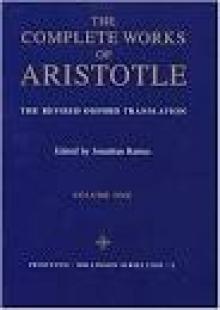 Various Works
Various Works